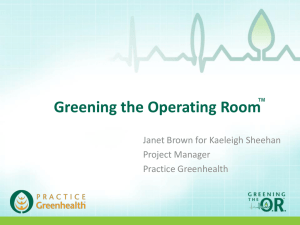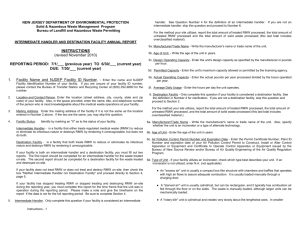Policy for the Disposal of Regulated Medical Waste
advertisement
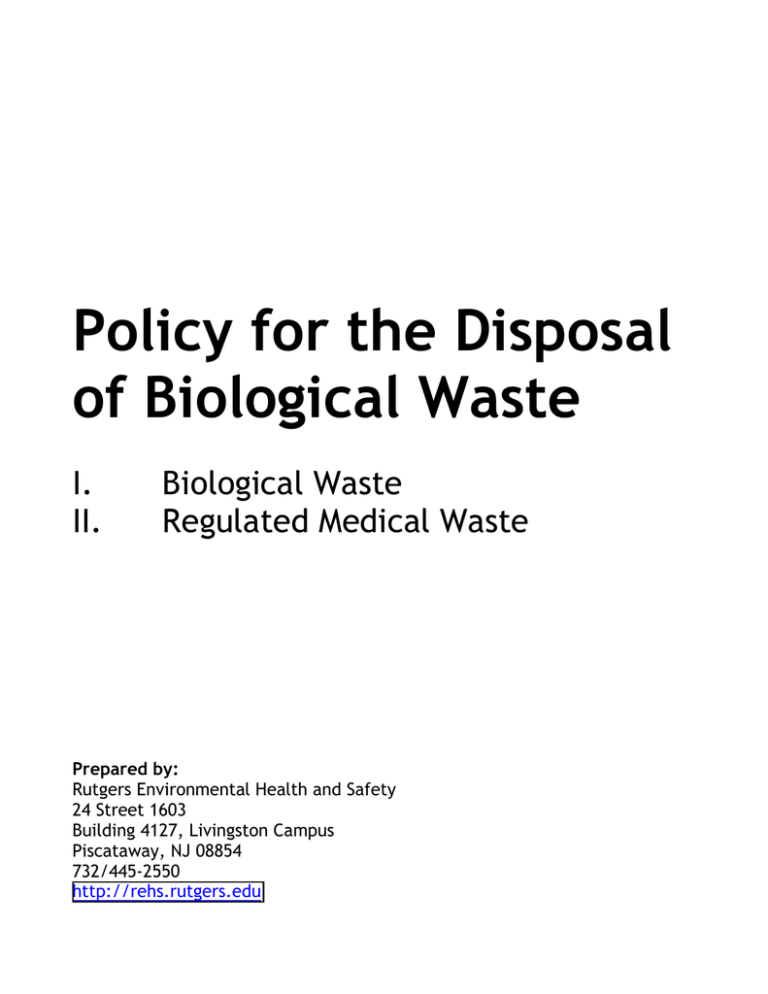
Policy for the Disposal of Biological Waste I. II. Biological Waste Regulated Medical Waste Prepared by: Rutgers Environmental Health and Safety 24 Street 1603 Building 4127, Livingston Campus Piscataway, NJ 08854 732/445-2550 http://rehs.rutgers.edu Table of Contents I. II. Biological Waste A. Biosafety Level 1 Laboratories Autoclave Procedures B. Biosafety Level 2 Laboratories Autoclave Procedures Regulated Medical Waste A. Definition of RMW 1. Process Definition 2. Classification Definition Classes of Medical Waste B. Overclassified RMW C. Segregation of RMW D. Treatment of RMW E. Storage of RMW F. Limitations on Storage of RMW G. Packaging, Labeling and Marking Requirements H. Tracking Form for RMW I. RMW Inspection J. Scheduling a RMW Pickup K. Supplies Available from REHS L. Definitions Appendix 1 Appendix 2 Regulated Medical Waste Tracking Form Biological Waste Management Table Page 1 1 1 1 2 2 3 3 3 3 4 4 4 4 5 5 5 6 6 6 6 9 11 Policy for the Disposal of Biological Waste I. Biological Waste Laboratories that are engaged in research regulated at Biosafety Level 1 or Biosafety level 2 must abide by the following policy. A. Biosafety Level 1 Laboratories All solid waste items which are potentially contaminated with microorganisms, tissue culture, cell culture, recombinant DNA, genetically engineered organisms, or genetically engineered plants regulated by the CDC/NIH, USDA/APHIS, or ATCC at Biosafety Level 1 (BL-1) must be autoclaved prior to disposal in the building trash dumpster. Such items should be placed into a clear autoclave bag. Rutgers University prohibits the use of red autoclave bags or bags with the biohazard symbol for the disposal of BL-1 waste. Autoclave Procedures 1. The clear autoclave bag should be filled to two-thirds of its capacity. 2. After the bag is 2/3 full, it should be loosely taped closed and labeled with the investigator’s name. 3. Autoclave tape should be affixed to the exterior of the bag to ensure the waste has received proper autoclave time, temperature, and pressure. 4. REHS periodically challenges autoclaves throughout the university to ensure that biological waste is being appropriately disinfected. Please contact REHS at 732/4452550 to arrange for an autoclave challenge. 5. Please see the Rutgers University Biological Safety Guide for additional information on autoclaving. All liquid waste items must be autoclaved or chemically disinfected (with 10% bleach solution or other appropriate disinfectant) prior to drain disposal of the liquid. All laboratories working with recombinant DNA, genetically engineered organisms, or genetically engineered plants must submit a “Registration Document for Recombinant DNA Experiments” for approval by the Rutgers University Biological Safety Committee. This form is available on the REHS website at http://rehs.rutgers.edu or by calling 732/445-2550. B. Biosafety Level 2 Laboratories All solid waste items which are potentially contaminated with microorganisms, tissue culture, cell culture, recombinant DNA, genetically engineered organisms or genetically engineered plants which are regulated by the CDC/NIH, USDA/APHIS, or ATCC at Biosafety Level 2 (BL-2) must be autoclaved and placed into the Regulated Medical Waste stream as Overclassified Medical Waste as outlined below. The following autoclave procedures should be followed when processing biological waste generated in BL-2 laboratories. Note: The color of the autoclave bags used to package BL-2 laboratory waste is unimportant since the waste is packed in the Regulated Medical Waste (RMW) boxes for ultimate disposal after processing. 1 Autoclave Procedures 1. The autoclave bag should be filled to two-thirds of its capacity. 2. After the bag is 2/3 full, it should be loosely taped closed and labeled with the investigator’s name. 3. Autoclave tape should be affixed to the exterior of the bag to ensure the waste has received proper autoclave time, temperature, and pressure. 4. REHS periodically challenges autoclaves throughout the university to ensure that biological waste is being appropriately disinfected. Please contact REHS at 732/4452550 to arrange for an autoclave challenge. 5. Please see the Rutgers University Biological Safety Guide for additional information on autoclaving. All liquid waste items must be autoclaved or chemically disinfected (with 10% bleach solution or other appropriate disinfectant) prior to drain disposal of the liquid. All laboratories working with recombinant DNA, genetically engineered organisms, or genetically engineered plants must submit a “Registration Document for Recombinant DNA Experiments” for approval by the Rutgers University Biological Safety Committee. All laboratories working with tissue culture, cell culture, pathogenic microorganisms, human blood, or human tissue that is regulated at BL-2 must submit a “Registration Document for Biohazards” for approval by the Rutgers University Biological Safety Committee. These forms are available on the REHS website at http://rehs.rutgers.edu or by calling 732/445-2550. II. Regulated Medical Waste The following instructions apply to generators of Regulated Medial Waste (RMW). At Rutgers University, RMW generators may be engaged in health care delivery, athletics or biomedical research. Rutgers laboratories that work with human blood must complete a Registration Document for Biohazards. This form is available from REHS and must be submitted for review and approval by the University Biological Safety Committee. In addition, Rutgers University employees who are reasonably anticipated to come into contact with human blood or blood products must adhere to the Rutgers University Bloodborne Pathogen program. Please contact REHS at 732/445-2550 for information on the Bloodborne Pathogen program. All generators of RMW must attend an initial RMW Orientation session provided by REHS. If you plan to generate RMW please contact REHS at 732/445-2550 to arrange for an orientation session. The initial orientation session is provided as needed to individuals, groups, or laboratories. The following procedures for the proper processing, transportation, and ultimate disposal of RMW are taken from the Comprehensive Regulated Medical Waste Management Act (N.J.S.A. 13:1E-48) and the NJDEP Solid and Hazardous Waste Rules subchapter 3A: Regulated Medical Wastes (N.J.A.C. 7:26-3A). 2 A. Definition of RMW: The Regulated Medical Wastes subchapter 3A (N.J.A.C. 7:26-3A.6) defines RMW as solid waste that meets both the process definition and the classification definitions listed below. 1. Process Definition: RMW is any solid waste generated from one of the following processes: the diagnosis, treatment or immunization of humans or animals; research pertaining to the diagnosis, treatment or immunization of humans or animals; or the production or testing of biologicals. 2. Classification Definition: To be considered as RMW, items that are included in the above process definition must also belong to one of the following classes of regulated medical waste. Classes of Regulated Medical Waste Class Class 1 Class 2 Class 3 Class 4 Class 5 Class 6 Class 7 Waste Type Example Cultures Cultures and stocks of infectious agents and associated biologicals: and Stocks cultures from medical or pathological labs; cultures and stocks of infectious agents from research labs; wastes from the production of biologicals; discarded live and attenuated vaccines; culture dishes and devices used to transfer, mix, or inoculate cultures Pathological Human pathological wastes including tissues, organs, and other Wastes body parts and fluids that are removed during surgery or autopsy or other medical procedures; specimens of body fluids and their containers Human Liquid waste human blood; items saturated, dripping or caked with Blood & human blood (including serum, plasma and other blood Blood components) which were used or intended for use in either patient Products care, testing and laboratory analysis, or the development of pharmaceuticals. Intravenous bags, soft plastic pipettes and plastic blood vials are also included in this category. Sharps Sharps that were used in animal or human patient care or treatment in medical research or industrial laboratories. Includes hypodermic needles, all syringes to which a needle can be attached (with or without the needle), Pasteur pipettes, scalpel blades, blood vials, carpules, needles with attached tubing, and broken or unbroken glassware (slides and coverslips) that were in contact with infectious agents. Animal Contaminated animal carcasses, body parts, and bedding of animals Waste that were known to have been exposed to infectious agents during research, production of biologicals, or testing of pharmaceuticals. Isolation Biological waste and discarded materials contaminated with blood, Waste excretions, exudates, or secretions from humans or animals that are isolated to protect others from certain highly communicable diseases. Unused Unused, discarded sharps that were intended to be used. Includes Sharps hypodermic needles, suture needles, syringes and scalpel blades. 3 B. Overclassified RMW: Overclassified RMW is material that does not meet the strict definition of RMW listed in part A, above. Overclassified RMW materials resemble RMW but are generated from activities that do not meet both the “process” definition and the “classification” definition of RMW. Examples of these materials include blood products generated in teaching laboratories (while research laboratories are covered in the process definition, teaching laboratories are not) or culture dishes generated in basic research laboratories (because these materials are not being used in research pertaining directly to the diagnosis, treatment or immunization of humans or animals). To avoid confusion and to prevent problems stemming from misconceptions about RMW, such materials should be collected for disposal as overclassified RMW. Overclassified RMW must be packaged and labeled in the same manner as RMW and is collected by the RMW vendor. There are also many activities that do meet the process definition but generate waste that does not belong in any of the seven specific classes. An example of this material would be gloves worn during blood drawing procedures in health centers (because gloves, unless they are either saturated with blood or contaminated with an infectious disease agent are not included as one of the seven classes of RMW). This waste should be packaged and labeled as overclassified RMW. C. Segregation of RMW: As RMW is generated it must be segregated into the following three categories: sharps (both class 4 and class 7), fluids (greater than 20cc), and other RMW. Collect each type of RMW in separate inner containers that will ultimately be placed into the outer cardboard container (i.e. needles, glass cover slips, scalpel blades and syringes must be collected in a sharps container; culture transfer devices, blood soaked items, and other paper or cloth related items must be collected in autoclave bags or red RMW liner bags.) Do not chop, bend, break or otherwise destroy hypodermic needles or syringes before discarding them into the sharps container. D. Treatment of RMW: Generally, it is not necessary to treat RMW or overclassified RMW before placing it in the outer cardboard container for ultimate disposal. However, Rutgers University policy requires that laboratories working with human pathogens regulated by the CDC or NIH at Biosafety Level 2 or higher must autoclave or chemically disinfect their waste prior to placing the waste into RMW boxes for collection by the RMW vendor. Once autoclaved, this waste material is considered overclassified RMW. E. Storage of RMW: Outer containers must be stored in a secure area protected for the elements, vandalism, insects and rodents. Unauthorized personnel must be denied access to this designated storage area. REHS recommends that RMW boxes not be stored in common areas, e.g. autoclave rooms. If RMW is to be stored in a common area, the location must be secured, e.g. locked, and the door appropriately labeled. When storing containers, be sure that their labels face outward so that they can be easily seen. Containers must also be sealed securely to prevent spillage or the leaking of vapors. Liquids (e.g. blood) must be put into containers that are packaged with a sufficient amount of surrounding absorbent material to prevent leakage. Volumes of liquid may not exceed 20cc per individual container. 4 F. Limitations on Storage of RMW: NJDEP Solid and Hazardous Waste Rules subchapter 3A: Regulated Medical Wastes (N.J.A.C. 7:26-3A) allows RMW to be stored on site for up to one year. In order to comply with this subchapter, RMW generators must dispose of RMW containers on a yearly basis, even if RMW containers are not full. REHS recommends frequent disposal of RMW boxes. G. Packaging, Labeling and Marking Requirements Packaging: The generator must package all RMW before the RMW vendor can remove it. The RMW vendor will not package your waste. All needles, syringes, scalpels and any sharp objects must be packaged in the appropriate punctureresistant sharps container. Unbroken as well as broken glass must be packaged to prevent puncture of the outer RMW container. All other items may be packaged in autoclave bags or other appropriate inner containers. These items must then be packaged in an appropriate medical waste box before removal. Boxes used for the first shipment of RMW can be obtained by contacting REHS at 732/445-2550. Replacement boxes for use with future disposal of RMW will be available from the waste vendor upon arrival for subsequent pickups. Only the outer containers supplied by REHS or the vendor may be used to package RMW. Labeling and Marking: Generators shall mark each package of RMW according to the following labeling and marking requirements before it can be transported offsite by the RMW vendor. The outermost surface of each cardboard box prepared for shipment shall be labeled with a special water resistant identification label called “Medical Waste Outer Container Label.” The Medical Waste Outer Container Label is available from REHS and provides the following information: campus, building and room where waste was generated. If these labels are unavailable, the required information may be written directly on the outside of the box. Only indelible or waterproof ink or marker fluid may be used to complete this label. In addition to the requirements above, the generator must label inner containers including sharps containers and fluid containers. Each inner container shall be labeled only with a special water resistant identification label called “Medical Waste Inner Container Label.” The Medical Waste Inner Container Label is available from REHS and provides the following information: campus, building, room, phone number and contact person name for the location where the waste was generated. If these labels are unavailable, the required information may be written directly on the inner container. Only indelible or waterproof ink or marker fluid may be used to fill out this label. Note that all containers, both inner and outer, must be marked with the required information. Labels may be obtained by contacting REHS at 732/445-2550. H. Tracking Form for RMW: The NJ Medical Waste Tracking Form (Appendix 1) is used to ensure proper transportation of RMW to an appropriate disposal site. Rutgers University has arranged with the RMW vendor to supply the four-copy RMW Tracking Form. The RMW vendor will fill out the tracking form. The generator must check Items 1 through 14 on the tracking form for purposes of verifying the accuracy of the information listed. After a thorough review of items 1 through 14, the generator must 5 then sign Item 15 of the tracking form. After the RMW transporter has also signed in Item 16, Copy 4 (goldenrod sheet) of the tracking form will be given to the generator. After the RMW is received by the disposal facility, a disposal facility representative will sign in Item 22. Copy 1 (white sheet) will be mailed back to the generator. Both Copies 1 and 4 of the tracking form must be kept by the generator at the generation site for at least three years from the date the waste was accepted by the RMW transporter. The destination facility must send Copy 1 to the generator within 15 days of receipt of the tracking form from the RMW hauler. I. RMW Inspection: Periodically, the New Jersey Department of Health and Senior Services inspects RMW compliance at Rutgers University facilities. The inspector may visit health centers, laboratories, or athletic training areas. It is important to have both the white and goldenrod copies of the tracking forms readily available, as the inspector will likely review your waste tracking procedures. Container labeling is also an area that may be reviewed by an inspector, so it is good practice to be sure both inner and outer container labels are affixed to RMW containers. J. Scheduling a RMW Pickup: Call REHS at 732/445-2550 to schedule a pickup of RMW. The RMW vendor is on site (Busch/Livingston and Cook/Douglass) on alternate Thursdays. Depending on the date of your request, you should allow up to 16 days for the RMW transporter to remove the waste. It is important that all requirements be completed prior to a pickup (e.g. labeling of the inner and outer container and sealing the box). Also, it is important that a representative of the RMW generator be on site to facilitate the RMW pickup. The RMW vendor will not pick up the waste without a representative of the RMW generator being present to sign the RMW tracking form. K. Supplies Available from REHS: REHS will provide the following items upon request. (REHS does not provide sharps containers, autoclave bags, packing tape to Rutgers University laboratories. It is the responsibility of individual laboratories to provide sharps containers, autoclave bags, and packing tape.) Please call 732/4452550 to request any necessary supplies. RMW outer container box RMW outer container box liner (red bag) 5-gallon open head bucket Inner container label Outer container label L. Definitions “Biologicals” means preparations made from living organisms and their products; includes vaccines and cultures intended to be used for diagnosing, immunizing, or treating humans or animals or in research pertaining thereto. “Blood Products” means any product derived from human blood, including blood plasma, platelets, red or white blood corpuscles; and other derived licensed products including interferon, etc. 6 “Generator” means any person, by site, whose act or process produces regulated medical waste as defined in N.J.A.C. 7:26-3A.6, or whose act first causes a regulated medical waste to become subject to regulation. “Infectious agent” means any organism (such as a virus or bacteria) that is capable of being communicated by invasion and multiplication in body tissues and capable of causing disease or adverse health impacts in humans. “Inner container” means any container (sharps container, autoclave bag, 5-gallon bucket) that would collect RMW and would ultimately be placed into a properly lined outer container. This container must be labeled with the “inner container label.” “Inner container label” means the label available from REHS which states the campus, building, room, phone number and contact person name for the location where the RMW was generated. “Laboratory” means any research, analytical, or clinical facility that performs health care related analysis or service. This includes medical, pathological, pharmaceutical, research, commercial and industrial laboratories. “Medical waste” means any solid waste that is generated in the diagnosis, treatment, or immunization of human beings or animals; in research pertaining thereto; in the testing of biologicals; or in home self-care. “Outer container” means the cardboard box that is supplied by the RMW vendor or REHS to collect inner containers of RMW. This outer container must be lined with a red RMW bag prior to placing any inner containers into the box. This box also must be labeled with the “outer container label.” “Outer container label” means the label available from REHS which states the campus, building and room where RMW was generated. “Transporter” means a person engaged in the off-site transportation of regulated medical waste by air, rail, highway, or water. 7 Appendix 1 Regulated Medical Waste Tracking Form Appendix 2 Biological Waste Management Table Biological Waste Management WASTE TYPE EXAMPLES PROCESSING INSTRUCTIONS REGULATED MEDICAL WASTE (RMW) BIOHAZARDOUS WASTE OVERCLASSIFIED MEDICAL WASTE NONCONTAMINATED LABWARE BIOLOGICALLY CONTAMINATED SHARPS Labware that has been used to manipulate sterile media, buffers, water, and other innocuous materials may be considered noncontaminated labware. This material may not be placed directly into the regular trash due to perceived hazards associated with waste material of laboratory origin. Sharps that were used in animal or human patient care, treatment, or biomedical research including hypodermic needles, all syringes with or without the attached needle, pasteur pipettes, scalpel blades, blood vials, needles with attached tubing, used microscope slides and cover slips. Hypodermic needles, suture needles, syringes, and scalpel blades. Place material directly into black plastic bag. Label bag “noncontaminated labware” prior to placement in dumpster. Place sharps directly into leak-proof puncture resistant commercially available sharps container. Never uncap, recap, bend, break, or shear attached needle from a syringe. Place sharps directly into leak-proof puncture resistant commercially available sharps container. Never uncap, recap, bend, break, or shear attached needle from a syringe. NONCONTAMINATED OR UNUSED SHARPS Cultures and stocks of pathogenic microorganisms, e.g., those organisms regulated at BL-2 or higher. Solid waste (e.g., culture flasks, petri dishes, pipettes, pipette tips, gloves) potentially contaminated with pathogenic microorganisms. The NJ RMW statute considers the following items to be RMW: cultures and stocks of infectious agents and associated biologicals; human pathological waste; human blood and blood products; needles, syringes, and sharps; contaminated animal waste including carcasses; hospital isolation waste; and unused sharps. Autoclave or chemically disinfect prior to placing material in labeled regulated medical waste box, lined with red bag, for collection by vendor. Once autoclaved, this waste material is considered overclassified RMW. Yes Place material directly into labeled RMW box, lined with red bag, for collection by vendor. Overclassified RMW is generated from activities that do not meet the legal definition of RMW. Examples include blood products generated in teaching labs (research labs are covered but teaching labs are not) or culture dishes generated in basic research labs (materials not used in research into the diagnosis, treatment or immunization of humans or animals). Place material directly into labeled RMW box, lined with red bag, for collection by vendor. No No No No No Collect waste material in lidded container lined with autoclave bag. Exterior of container to be labeled with biohazard symbol. Transport autoclave bags, sealed with autoclave tape, to autoclave room in a covered leak-proof container. Once autoclaved (or chemically disinfected) processed material is placed in RMW boxes for collection by vendor. Transported by vendor to approved RMW incinerator for off-site incineration. Generator to retain RMW Tracking Forms. Place material directly into labeled RMW box, lined with red bag, for collection by vendor. Smaller containers placed within the RMW box (e.g., sharps containers) must be labeled with inner RMW label. Place material directly into labeled RMW box, lined with red bag, for collection by vendor. Handle overclassified RMW in the same manner as RMW. Place material directly into black plastic bag. Label bag “noncontaminated labware” prior to placement in dumpster. When full seal bag and transport to dumpster or make arrangements with building services to transport to dumpster. When full seal sharps container, label with inner RMW label, and place in labeled RMW box, lined with red bag for collection by vendor. When full seal sharps container, label with inner RMW label, and place in labeled RMW box, lined with red bag for collection by vendor. Transported by vendor to approved RMW incinerator for off-site incineration. Generator to retain RMW Tracking Forms. Transported by vendor to approved RMW incinerator for off-site incineration. Generator to retain RMW Tracking Forms. Placed into dumpster by laboratory personnel or building services. Collected by solid waste carting vendor and transported to landfill. Transported by vendor to approved RMW incinerator for off-site incineration. Generator to retain RMW Tracking Forms. Transported by vendor to approved RMW incinerator for off-site incineration. Generator to retain RMW Tracking Forms. AUTOCLAVING REQUIRED CONTAINER DISPOSITION
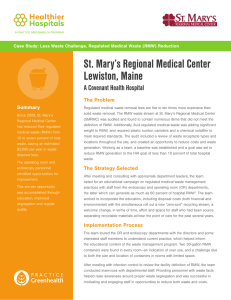
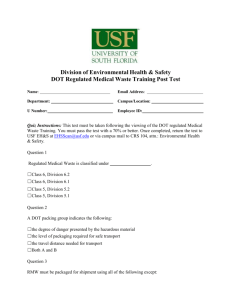
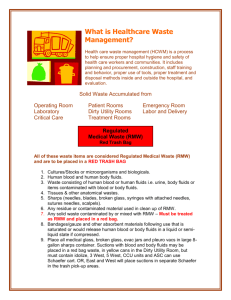
![Anti-PSD95 (phospho T19) antibody [EPR2619(2)] ab172628](http://s2.studylib.net/store/data/012640149_1-5c8251e22b19cc48110c231a9a7c69d1-300x300.png)
